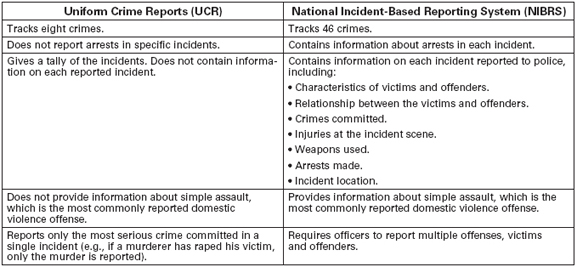|
|
| Expanding Police Ability to Report Crime: The National Incident-Based Reporting System |
| By National Institute of Justice |
| Published: 07/20/2009 |
 The Problem
The Problem
The Uniform Crime Reports (UCR) is the FBI’s widely used system for recording crimes and making policy decisions. It has tracked data on seven crimes since 1930: murder, robbery, rape, aggravated assault, burglary, theft and vehicle theft. In 1979, the UCR started reporting on arson. Today, nearly 17,000 law enforcement agencies report UCR data to the FBI. UCR data have several limitations that make them unsuitable for analyzing local crime. For instance, the UCR does not provide specific information on each incident (e.g., location, characteristics of the victim and offender, and injuries they received). If multiple crimes occur at the same scene, only the most serious is recorded. The UCR also does not allow police to report whether an arrest was made at the crime scene. The Solution In the 1980s, the FBI began to revise the UCR. The result was the National Incident-Based Reporting System (NIBRS). As of 2004, NIBRS data came from 5,271 law enforcement agencies that represent about 20 percent of the total U.S. population. NIBRS enhances the UCR data because it describes details about 46 types of criminal activity. Officers can record specific information about each incident, including unique descriptions of victims and offenders, a description of each crime that occurred at the scene, and whether an arrest was made.  The impact NIBRS significantly expands officers’ ability to record data about a specific incident, which gives leaders a much fuller understanding of crime. As a result, a mayor’s policy advisor or a police executive can look at NIBRS data alone or combine them with other citywide data, analyze them, and gain a more descriptive view of criminal activity in the community. NIBRS data help law enforcement gather better evidence to develop effective solutions and practices. Researchers find NIBRS data useful and have successfully used NIBRS data to:
For more information about NIBRS, see the FBI’s Frequently Asked Questions page at http://www. fbi.gov/ucr/faqs.htm, or find NIBRS statistics on the Bureau of Justice Statistics Web page at http:// www.ojp.usdoj.gov/bjs/nibrs.htm#about. Notes
|
MARKETPLACE search vendors | advanced search

IN CASE YOU MISSED IT
|


Comments:
No comments have been posted for this article.
Login to let us know what you think